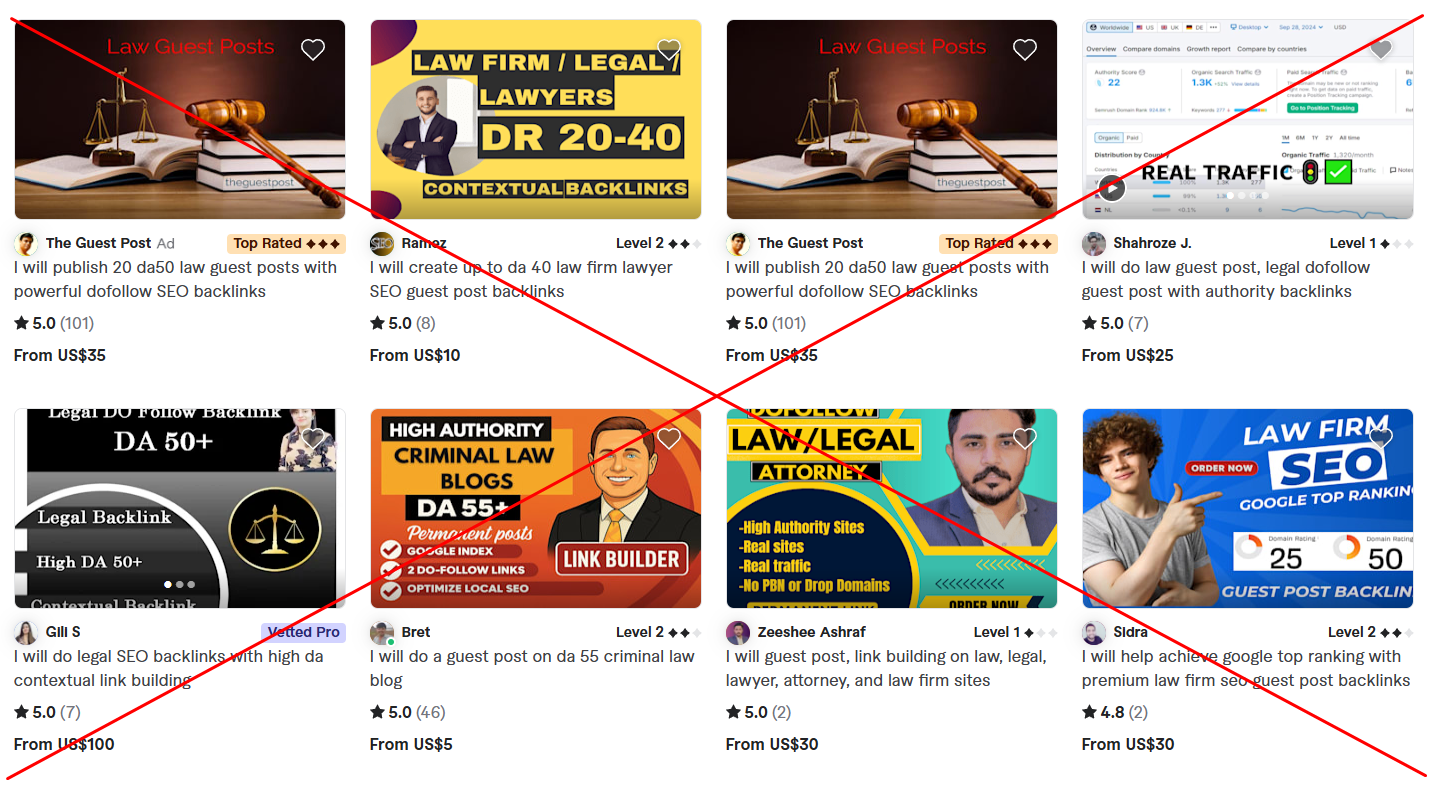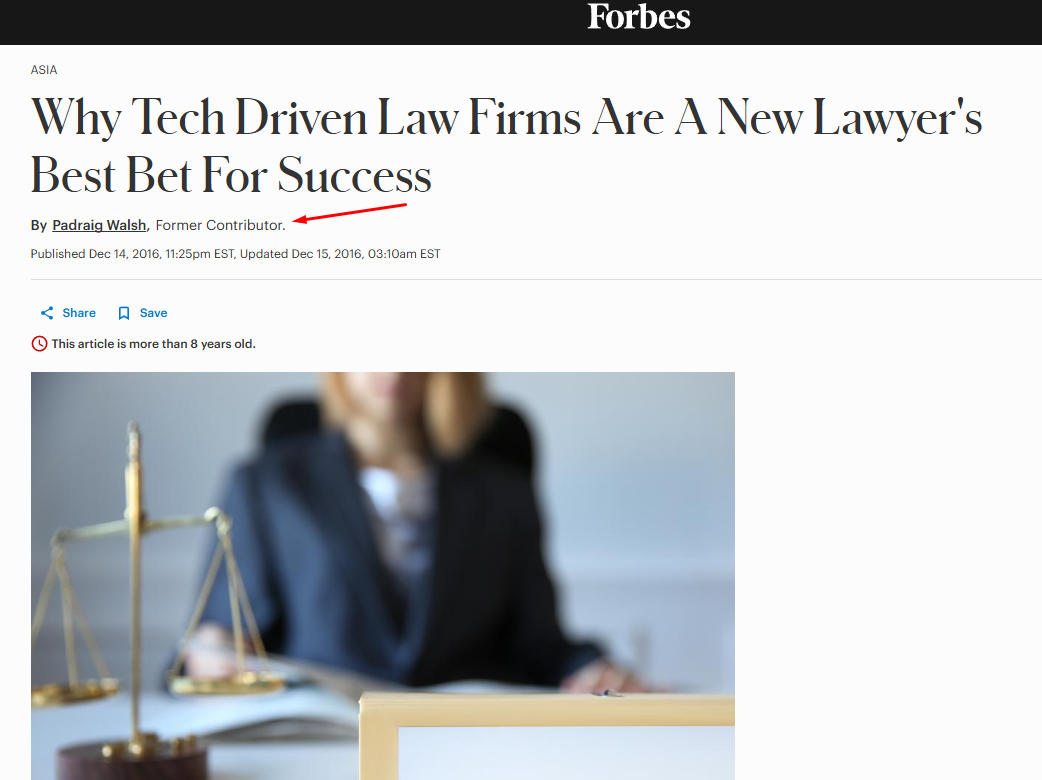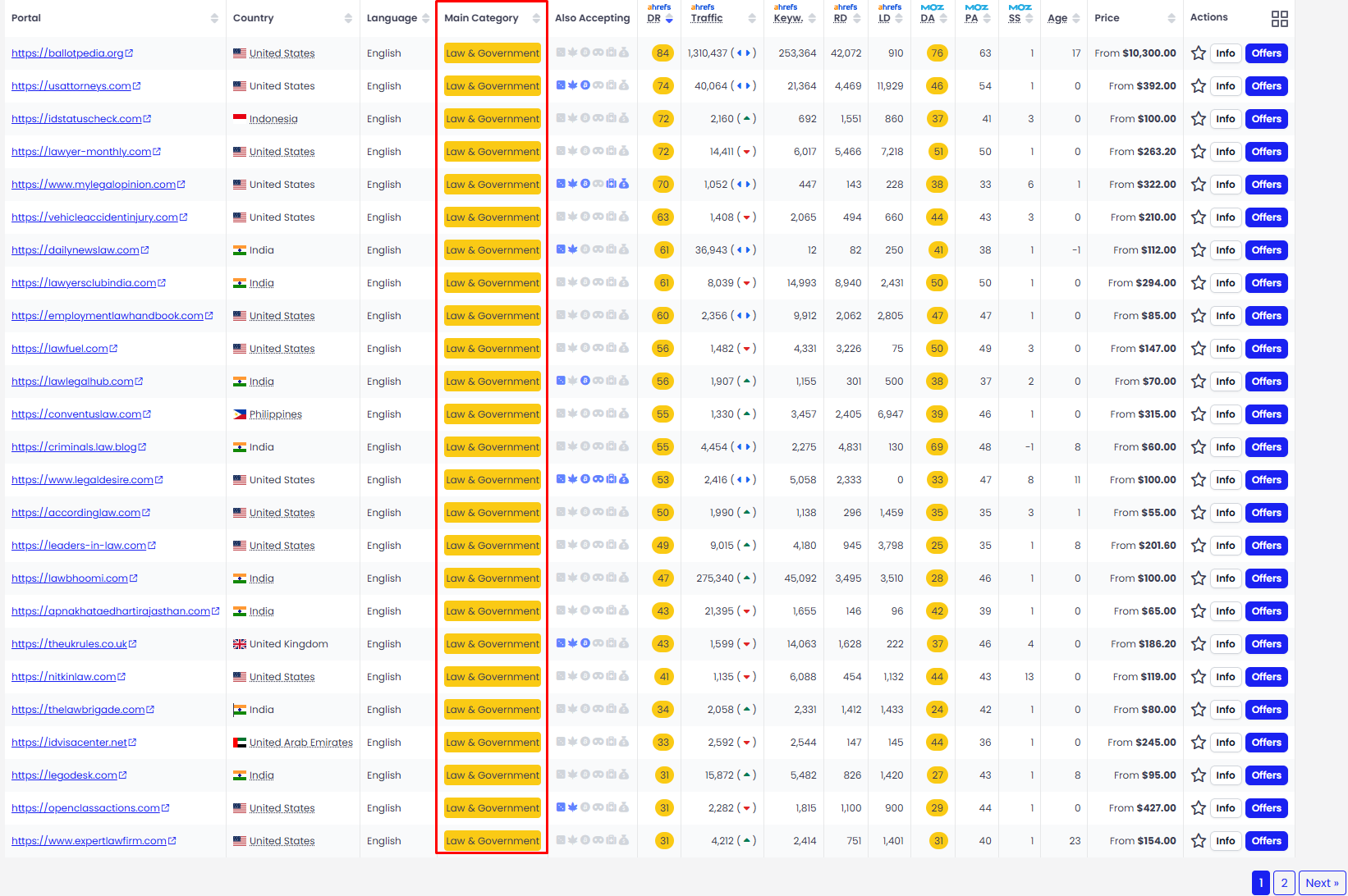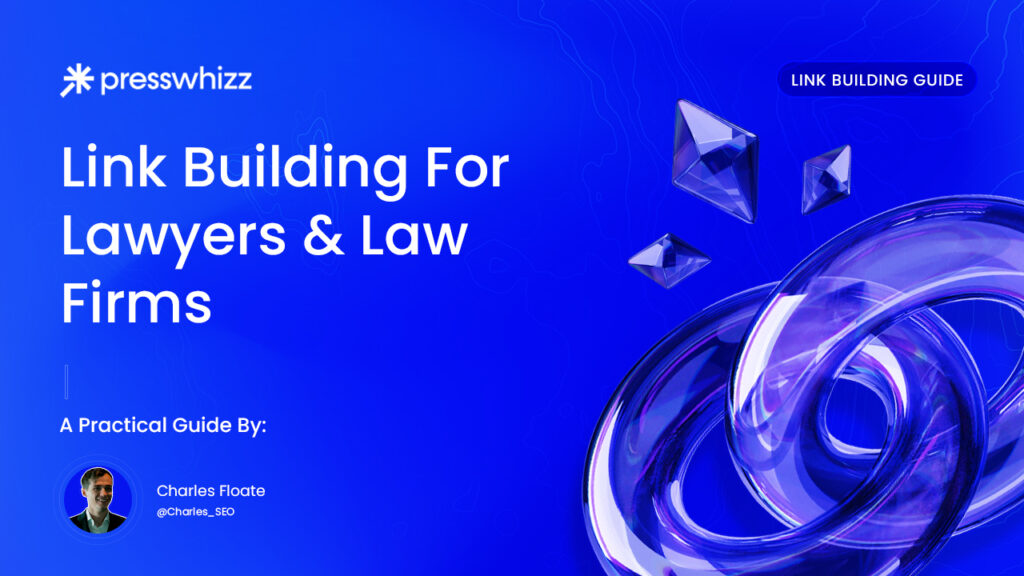If you’re an attorney, law firm, or managing legal marketing for clients, then you’re playing in one of the highest ticket, most profitable SEO niches on the internet!
The average CPC for law keywords in the US often makes crypto look like pocket change… And the value of a single lead can easily be five, six or even seven figures in some areas. That means the competition, and those building and buying links, are often paying large monthly retainers to do so…
But most law firms are still using agencies running outdated tactics, buying garbage guest posts from “legal” blogs nobody reads, or pushing out press releases every week that often end up being negative signals, en masse…

You want to rank for highly competitive keywords and consistently bring in high ticket leads organically?
You need a strategy designed for the real world, where Google’s updates and features torched half the web, brand and authority signals have never been more important, and AI generated slop is everywhere, including seeping into legal content.
If you follow this guide, you’ll not only build the kind of links that actually rank law sites, but you’ll futureproof your site for whatever update Google tries to throw at you next.
I’ll show you how to get the biggest links in the game, rank your site and force AIs to recommend your brand!

No soft sells, no empty promises, just advice from consistently ranking pages for attorneys for the past 12 years.
Link Building for Lawyers
You can do SEO for plumbers and electricians, but for lawyers, the stakes are higher! The average link price is triple or more, you often have to fit very strict publishing criteria or frameworks that meet legal requirements – And you’re up against agencies who’ve been buying up every niche relevant link under the sun for a decade.
Here’s why lawyers, attorneys, and law firms have it especially rough, and, if you play it right, why you can absolutely dominate these SERPs:
-
Every Link is Expensive: Law is a high value, “your money or your life” (YMYL) vertical. Publishers know this, so expect to pay a premium for anything that isn’t trash tier – And top tier publishers often charge you extra for content beyond 1,000 words.
-
Authority Trumps All: Google is on an authority binge post-2024. If you’re not getting links from sites with real editorial control, and matching your the legal LinkGraph, you’re spinning your wheels.
-
Topical Relevance is Non-Negotiable: A DR80 mommy blog link isn’t moving the dial here… You need links from legal, business, authoritative industry publications and trusted news sites.
-
Regulation, Compliance & PR Sensitivity: One negative story, bad anchor, or dodgy placement and you’re in more trouble than any other type of client!
With the right systems, you can absolutely buy, build, or earn your way to the top of some of the most profitable SERPs in the world, and keep them!
Link Building Strategies For Law Firms
Here’s the field tested arsenal you actually need if you want to rank your legal sites or client sites:
1. True Authority PR
Forget using a press release syndication service to spam 300 sites no one reads every time anything happens with a case… Real PR means being referenced in news, industry media, local outlets, and even academic resources. Think DR70+ minimum, and editorial mention, not just a random link dump.
Here’s how you do authority PR the right way in 2025:
a. Leverage Newsworthiness, or Manufacture It
If you or your client have a real, recent story (big case win, precedent setting verdict, charity initiative etc…), work it! If you don’t, create one: Release a state-by-state legal trend report, commission a survey on a hot topic, or partner with a nonprofit for an event. Journalists need content; Give them angles that make you the authority.
b. Build a Rolodex, Not Just a Media List
You need personal connections – LinkedIn, X/Twitter, local journalist meetups. Befriend the editors, follow the right reporters, DM with a hook. Most big placements are given, not earned by cold email.
c. Use HARO, Qwoted, and Sourcebottle
The majority of HARO pitches are abysmal, AI generated garbage these days… Make yours tight, unique, and come from a real attorney with actual expertise. Take as much content from the principal lawyer of the firm, or the CEO, and build a customGPT that can build quotes from them they can approve for each publication you submit to.
Respond lightning fast, and give quotable lines. Always ask for a link if the quote is used (most will do it if you ask after they accept your quote).
d. Don’t Sleep on Local Media
The firms local business journal, newspaper, and even the radio blog all have higher trust in your local market than 99% of generic “legal” blogs. Target them for commentary, legal explainers, and thought leadership. Get quoted, get linked.
e. Paid PR Isn’t Dead, It Just Has to Be Strategic
You can buy placements, but if you’re doing it, make sure you’re on real sites with real editorial teams. Don’t waste money on press release syndication that’s deindexed in a week. Aim for placements where your competitors would kill to be mentioned.

Pro Tip: Always, always, always get links to your actual practice area pages, not just the homepage. Diversify anchor text (branded, generic, long-tail), and ensure every link is contextual and surrounded by relevant legal language.
2. Power Guest Posting
Guest posting in 2025 is not about volume, it’s about publisher equity.
And obviously, the larger the publisher, usually the larger the signals you’ll get passed to your site – As long as you are activating them, which we’ll get on to below:
- Only post where Google still crawls. Use Ahrefs to check traffic >1,000/mo minimum. If DR>60 but traffic=0 then skip it. It’s a zombie domain.
- Relevance trumps DR. A DR35 local business magazine that covers legal issues will outperform a DR80 “generic business” site for link trust in YMYL.
- Pitch smart, not spammy. Build a spreadsheet of journalists or editors on “legal innovation”, “business law”, and “small biz compliance”. Outreach with value, not “I wrote a guest post”, but “I noticed you haven’t covered XYZ ruling, we can provide legal commentary.”
- Use the lawyer’s face as the brand. Every post should have an author bio linking to their LinkedIn and firm site. You’re building E-E-A-T, not filler content.
- Tier 2 everything. Once a post goes live, build 5–10 links to that article itself (Twitter embeds, niche edits, even a PressWhizz tier 2 drip). It keeps the juice fresh.
Pro tip: Buy placement access via vetted marketplaces like PressWhizz, not Fiverr-tier “legal guest posts.” If the URL path looks like /contributor/guest-post-legal-seo/, you’re already devalued.
3. Digital Asset & Resource Building
You want link magnets, not PDFs no one reads.
- Build state-by-state legal data tools – “Average Personal Injury Settlements by State (2025)” or “Legal Aid Cost Index.”
→ Publish it, pitch it to local media and legal blogs. Data = backlinks. - Use AI for data mining. Use GPT-5 with a legal dataset to generate original insights; have a paralegal verify before publication.
Verified = journalist-safe. - Infographics + embeddables. Give journalists HTML snippets that link back to your tool. 10 of those = 10 followed embeds.
- Refresh annually. Add “2026 Edition” next year; each update = new outreach wave.
Goal: 1 flagship asset per practice area (e.g., family law trends, DUI conviction map, etc.) Each becomes a perpetual PR angle.
4. Local & Civic Sponsorships
Skip the fake scholarships, they’re saturated and flagged by Google’s spam team.
Instead:
- Sponsor local bar events, legal clinics, moot court competitions. These usually have
.eduor.orgbacklinks with real trust flow. - Partner with chambers of commerce and rotary clubs for local law-related awards. You’re buying relevance, not vanity.
- Set up a “Law for Good” initiative, pro bono hours, youth outreach, legal aid funding. Get it covered by local media and link to your about page.
- Bonus: Offer commentary on city council legal reforms → get cited on the city website itself.
These aren’t just backlinks, they’re trust signals that feed into entity stacking.
5. Relationship Engineering
Your best links don’t come from emails, they come from WhatsApp and DMs.
- Build your personal network of editors, journalists, and bloggers who cover legal, civic, or business beats.
Treat them like clients: remember birthdays, send gift cards, share leads. - Leverage your lawyers’ speaking gigs – every panel or podcast is a link opportunity. Repurpose that appearance as a “news update” and pitch it to other outlets for coverage.
- Create a micro-newsletter for journalists and podcasters, “Legal Trends Briefing”, short, quotable, and shareable.
Each mention earns you contextual links when cited. - Track relationships with a CRM. If they’re publishing legal content monthly, they should know your firm’s name by heart.
6. Outspend and Out-Strategize
Legal SEO is pay-to-play. The firms ranking #1 aren’t better lawyers, they’re better link buyers.
- Reverse engineer your competitors. Drop the top 10 firms into Ahrefs or PressWhizz Link Intelligence. Filter by DR>50 and “nofollow excluded.”
- Identify anchor patterns (how often “personal injury lawyer + city” appears). Emulate diversity, don’t copy aggressively.
- Outbuy with purpose. If they’re buying 5 DR70s a month, buy 7, but vary anchors and target pages.
Rotate between: homepage, practice area, case results, blog assets. - Build a monthly velocity curve that looks organic:
- Month 1–2: 10 links
- Month 3–5: 15–20 links
- Month 6+: steady 10/mo.
Google rewards consistency over bursts.
Grey hat tip: Use paid placements as your foundation, then pad them with free PR mentions and citations to mask footprint.
7. Anchor Diversity & Link Velocity
Legal niches are YMYL, and Google is hypersensitive to anchor spam.
Anchor playbook:
- Branded (40%) – “Smith & Jones LLP”, “Smith & Jones injury lawyers”
- Generic (25%) – “this firm”, “learn more”, “click here”
- Long-tail (20%) – “attorneys specializing in employment law in Florida”
- Exact-match (≤10%) – reserved for your strongest DR75+ contextual links only.
Link velocity:
- Avoid sudden spikes (20+ new DR80 links in 2 weeks = red flag).
- Keep it steady. Growth looks organic when paired with regular press or blog updates.
- Don’t count pillow links (Reddit, Crunchbase, LinkedIn) in your velocity model, they’re trust anchors, not ranking triggers.
8. Niche Edits (Link Insertions)
The fastest, cheapest, stealthiest weapon in your arsenal, when done right.
- Target aged, indexed, high-traffic articles on business, legal, or local news sites. The page should already rank for related terms.
- Insertion angle: “Legal expert commentary added post-publication.” Offer to update old articles with new legal insights and a contextual link.
- Vet pages for indexation + relevance, no “casino” footprints, no link-farm sidebars.
- Use AI (PressWhizz or custom GPT) to find insertion prospects at scale:
“site:businessjournal.com intitle:‘employment law’ -guest -sponsored” - Tier 2 backlinks your best edits with social embeds or press mentions, keeps the juice flowing longer.
- Don’t overdo it. 3–5 solid niche edits monthly can outperform 10 mediocre guest posts.
Most Forget These Steps
Ranking is only half the battle. Most law firms focus entirely on acquiring links without ever converting the authority they’ve built into pipeline.
Let me be blunt, if you’re buying, building, or earning high authority links, but sending that trust to a homepage with a stock gavel photo and a “Contact Us” button, you’re wasting 90% of your SEO potential.
Authority must flow intentionally through your funnel. Here’s how to engineer it.
Direct Authority to Where Money is Made
Your homepage is rarely where people convert, your practice area and geo-intent pages are.
That means your anchor and internal link flow must push PageRank to those URLs deliberately.
Example structure for a personal injury firm:
- Homepage → Practice Area Pages → Blog Assets → Local Landing Pages
- Each blog or PR placement must funnel internal links back to “Car Accident Lawyer in [City]” or “Truck Injury Claims.”
My Personal Blueprint:
- Top-tier DR70+ placements? → Point directly to practice pages (contextually).
- Mid-tier DR40–DR60 guest posts or edits? → Link to blog assets or “resource” content that internally links to practice pages with natural anchor text.
Authority flows, it doesn’t teleport. Map your internal link structure like a circuit board, every wire should end in a lead capture page.
Build a Semantic Fortress
Google’s “Helpful Content” classifiers and co aren’t rewarding volume; it’s rewarding semantic dominance.
Every practice area page (e.g., “Divorce Lawyers in Chicago”) should be surrounded by a content cluster of supporting topics that all internally link back to that page.
For example:
- “How long does a divorce take in Illinois?”
- “Illinois child custody laws: 2025 update”
- “What to bring to your first consultation with a divorce attorney”
Each of those can earn backlinks on its own, but their purpose is to amplify the main money page.
Then, power those clusters externally, with niche edits, guest posts, and HARO mentions all reinforcing that semantic focus.
When you stack relevance + authority correctly, you’re not building random links… you’re constructing legal topical authority that’s algorithm-proof.
Feeding Google’s Entity Machine
Google doesn’t trust websites in YMYL niches, it trusts entities.
If your firm isn’t a recognized entity across multiple platforms, your backlinks lose contextual weight.
Here’s how to fix that fast:
- Entity Citations: Build consistent profiles on Crunchbase, Bloomberg, MarketWatch, local bar directories, and news publications that reference your firm name, founder, and location.
- Knowledge Graph Optimization: Ensure the same Name/Address/Phone/Schema data appears identically across your site, LinkedIn, Google Business Profile, and PR links.
- Use Schema Stack: Layer
Organization,Attorney, andFAQPageschema across your pages, then embedSameAsreferences to all verified social and press mentions.
This creates a unified digital footprint that Google’s algorithms can understand and trust.
You’re not just a firm with backlinks, you’re a verified authority entity.
The AI Visibility Advantage
The biggest SEO shift of 2024–2025 isn’t just algorithmic, it’s AI visibility.
Google’s Search Generative Experience (SGE) and AI-driven engines like Perplexity or ChatGPT retrievals are now entity-based.
That means the law firms they mention and recommend are those with:
- Consistent structured data (E-E-A-T reinforcement)
- High-authority mentions across credible sources (especially .gov, .edu, and major media)
- Active brand sentiment and citation velocity
You want to force AI systems to learn your brand. Here’s how:
- Feed them signals: Publish structured data-heavy pages. Tag every attorney as an author with verifiable credentials.
- Get cited in AI training datasets: Guest post on Medium, Substack, LinkedIn Articles, and Quora, all are indexed and scraped for AI retrieval.
- Leverage long-tail brand queries: Push “best [practice area] lawyers in [city]” as a headline across PR and guest content. You’re literally teaching Gemini and ChatGPT your topical relevance.
The goal? When users ask “Who are the top injury lawyers in Florida?”, your firm name appears inside the AI response, not just the SERP.
The Tiered Amplification System
Once you secure authority links, don’t let them rot.
This is where 90% of agencies fail. They build links, report them, and move on.
You want to amplify those links using tiered strategies that boost their PageRank flow.
- Tier 2: Build contextual edits, citations, and internal embeds linking to your earned backlinks.
- Tier 3: Social amplification (Twitter embeds, Reddit shares, niche forum posts) to keep those Tier 2s indexed and refreshed.
- Traffic injection: Run $5/day social ads to the referring URL for 2 weeks after publication. Google’s crawler sees traffic → recrawls → strengthens link value.
This is called authority activation, and it’s how you turn a DR70 link into a ranking signal multiplier.
What Actually Moves the Needle
Across hundreds of campaigns, the law firms that consistently dominate follow one formula:
| Link Type | Target Ratio | Cost Range | Purpose |
|---|---|---|---|
| Editorial PR / News | 20% | $500–$2,000 | Brand + E-E-A-T |
| Guest Posts (Real Sites) | 30% | $150–$500 | Contextual authority |
| Niche Edits | 25% | $100–$300 | Anchor variation + velocity |
| Local/Community Links | 15% | Free–$250 | Geo relevance |
| Foundational / Entity Links | 10% | Free | Trust & structure |
That’s your money distribution map, keep within those ratios and your growth curve looks natural, even at scale.
Compliance, Reputation & Damage Control
Law firms live under more scrutiny than any other SEO vertical.
That means one bad backlink, shady anchor, or irrelevant guest post can tank both rankings and brand trust.
Here’s how to stay above board without playing soft:
- Vet every site manually. Look for author profiles, indexation, and outbound link patterns. If the site’s last 10 posts are “casino,” “CBD,” and “crypto,” bin it.
- Anchor moderation: Never use exact-match anchors on sponsored content.
Use “Learn more from Smith & Jones injury lawyers” instead of “personal injury lawyer in Dallas.” - Continuous disavow system: Review your link profile quarterly and dump toxic backlinks. Tools like Link Research Tools or PressWhizz can automate this.
- Legal disclaimer page optimization: Believe it or not, even your disclaimer and privacy pages feed E-E-A-T credibility. Make sure they’re properly interlinked and crawled.
Performance Forecasting & ROI Attribution
Law firm link building is expensive, you can’t afford guesswork.
Forecasting ROI isn’t just for client decks; it’s how you plan velocity vs. return.
Create an Authority Forecast Model:
- Pull your DR, referring domains, and monthly organic traffic.
- Benchmark against top 3 competitors in Ahrefs.
- Forecast link velocity to hit parity within 6–9 months.
- Project revenue impact using your conversion rate and average case value.
If you spend $5K/month on links and average a $20K case intake per lead, even one additional client per month makes the campaign ROI-positive. That’s your boardroom argument for budget scaling.
The Endgame
The firms that truly dominate aren’t just ranking, they’re quoted.
They become the default legal resource that both journalists and AI systems rely on.
That’s your end goal:
To make your firm synonymous with authority so that backlinks become a byproduct of your reputation.
How?
- Publish annual data reports (Divorce Trends 2025, DUI Conviction Index, etc.)
- Secure expert roundups with media sites (LegalNews, Law360, Forbes).
- Create original legal commentary videos for YouTube Shorts and embed them into your blog posts for multimedia authority.
- Push syndication manually – When your report goes live, email 200 journalists with an embargoed headline. You’ll wake up to 10+ earned links overnight.
Final Thoughts
If you’re serious about winning lawyer SERPs, treat this like a capital deployment exercise, not “content marketing.” Set a risk tolerance (White / Grey), allocate a monthly links budget you can actually sustain for 6–12 months, and run it like a trading desk: weekly ops, monthly velocity reviews, quarterly re-forecasts. Every dollar must either buy trust (entity + PR), buy relevance (legal/business placements), or buy speed (edits + tiered amplification). Anything else is theatre.
Give someone the wheel. Legal SEO fails when 5 people “own it.” You need a single operator with authority to approve anchors, sign placements, and push dev/content for internal links and schema, fast. Wrap them with compliance (so we don’t trigger bar issues), a paralegal editor (to keep the law straight), and a VA to keep outreach/CRM immaculate. That’s your minimum viable team to scale links without leaving a footprint.
Then lock the operating cadence. 90 days is your first checkpoint:
-
Days 1–30: Entity cleanup, internal link map, first 10–20 high-relevance links live.
-
Days 31–60: Clusters published, Tier 2s on your best wins, PR pitch #1 shipped.
-
Days 61–90: Anchor audit, velocity tune, double down on what landed placements and ditch what didn’t.
If you can’t measure lift on practice pages by day 90 (rank movement, impressions, consults), change the mix, not the mission.
Finally, hold the work to a higher bar than your competitors. If a link won’t pass a “would we brag about this in a pitch deck?” test, don’t buy it. If a paragraph wouldn’t convince a judge it’s accurate, don’t publish it. If a placement wouldn’t impress a journalist or an LLM, it won’t move a YMYL needle. Ruthless quality control compounds, in rankings, in brand equity, and in the kind of cases you attract.
Do this properly and you won’t just outrank other firms, you’ll outlast them. Now go take market share!


